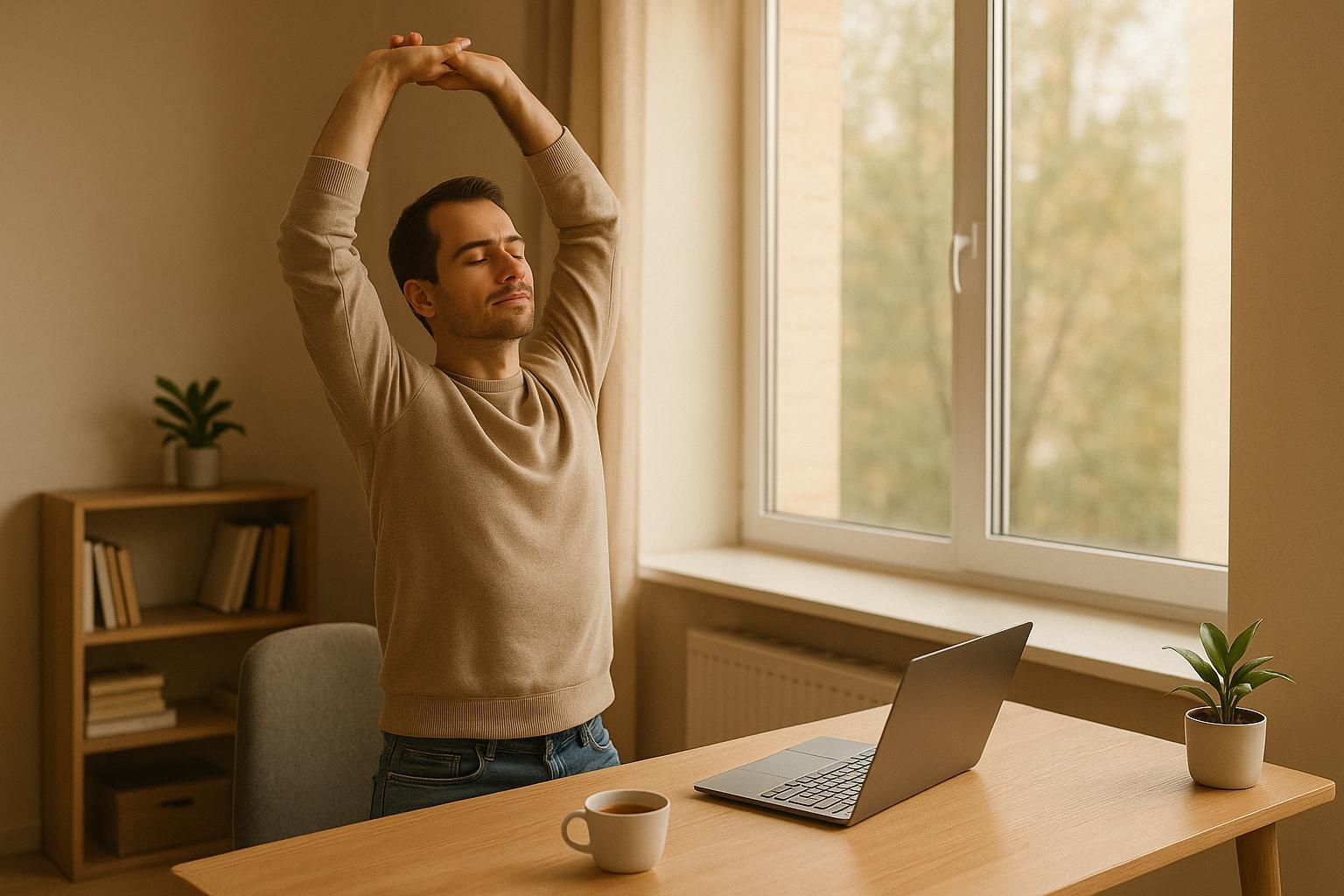Feeling stressed? Movement breaks can help.
Short, regular movement breaks – lasting just a few seconds to 10 minutes – can instantly reduce stress and improve focus. Here’s what you need to know:
- Why it works: Moving lowers stress hormones like cortisol and releases feel-good chemicals like endorphins.
- Quick benefits: Boosts mood, sharpens focus, and eases muscle tension.
- Long-term perks: Prevents burnout, improves sleep, and lowers the risk of chronic health issues like heart disease and diabetes.
- Easy ways to start: Stretch at your desk, take a short walk, or try desk yoga during work breaks.
Even a 2-minute stretch every 30 minutes can make a big difference. Start small, stay consistent, and let movement be your stress-busting secret.
Burn Off Excess Cortisol & Decrease Anxiety With These 4 Movements
How Movement Breaks Improve Your Health
Taking movement breaks isn’t just about stretching your legs – it’s about giving your body and mind a chance to reset. Even a few minutes of activity can spark changes that reduce stress and enhance your overall health.
Quick Benefits of Movement
The moment you start moving, your body releases a mix of feel-good chemicals like dopamine, norepinephrine, and serotonin, which can instantly lift your mood[4]. These natural boosts explain why even short bursts of exercise can make you feel more focused, alert, and ready to tackle your day[5].
Need an energy reset? A quick stretch or a brisk walk can help regulate your sleep patterns[5], making it easier to fall asleep and wake up refreshed. These small actions create a ripple effect, helping you build resilience against stress over time.
Long-Term Effects on Stress
While the immediate perks of movement are great, the long-term benefits are even more impactful. Regular movement breaks help reduce stress, improve mood, and restore your motivation. They also enhance creativity, memory, and learning while preventing fatigue and boosting productivity[10].
On a deeper level, exercise lowers stress hormones like adrenaline and cortisol while increasing endorphins – your body’s natural mood elevators[3]. Over time, this hormonal balance equips you to handle stress more effectively.
Movement also strengthens your body’s defenses against various health issues. Consistent exercise reduces the risk of heart attacks, strokes, diabetes, certain cancers, osteoporosis, and even cognitive decline[3][2]. By building a healthier body, you’re better prepared to face life’s challenges without feeling overwhelmed.
Let’s not forget the mental side of recovery. Taking breaks replenishes your energy and mental resources, reducing the risk of fatigue, sleep problems, and even cardiovascular issues[9][1]. It’s a simple yet powerful way to protect both your mind and body.
Mental and Emotional Benefits of Movement
Movement doesn’t just change your body – it transforms your mind and emotions too. Exercise has been consistently linked to better mental health and emotional well-being, with 89% of 1,158 studies showing a positive connection between physical activity and mental health[11].
Feeling overwhelmed? A movement break can help you regain a sense of control and confidence[6]. It’s a healthy way to process emotions and improve your self-esteem. Physical activity also relaxes tense muscles, which in turn calms your mind. This relaxation creates space for clearer thinking and better decision-making.
| Mental Health Benefit | How Exercise Helps |
|---|---|
| Reduced Stress | Triggers endorphin release and eases muscle tension[5] |
| Improved Mood | Boosts endorphins for a natural lift[3] |
| Enhanced Focus | Increases dopamine, norepinephrine, and serotonin levels[5] |
| Better Sleep | Helps regulate sleep cycles[5] |
| Higher Self-Esteem | Builds a sense of accomplishment and strength[5] |
| Stronger Resilience | Encourages healthy coping mechanisms[5] |
The protective effects against depression are particularly striking. A 2019 study found that running for just 15 minutes a day or walking for an hour can lower the risk of major depression by 26%[5][8].
Exercise also helps distract you from negative thoughts and gives you opportunities to try new things. Plus, if you work out with others, it adds a social element that can further reduce stress[6]. Whether it’s a solo jog or a group yoga class, movement offers a path to better emotional health and stronger resilience.
How to Add Movement Breaks to Your Day
You don’t need to completely revamp your schedule to add movement breaks to your day. With a few simple strategies, you can easily incorporate physical activity into even the busiest workdays.
Easy Movements for Work
Believe it or not, your workspace can double as a mini gym. Desk exercises are a quick way to boost your energy without needing special equipment or a wardrobe change.
If you’re seated, try exercises like oblique twists, seated bicycles, or leg lifts. A discreet option is glute squeezes – just tighten and release your glute muscles while sitting.
If you have the chance to stand, you can do triceps dips using your chair, desk pushups, calf raises, or wall sits. These moves are simple but effective.
Stretching is another easy way to add movement to your day, and it feels natural in an office setting. For example:
- Triceps stretch: Raise one arm, bend it so your hand reaches toward your back, and gently pull the elbow toward your head with your other hand.
- Overhead reach: Extend one arm overhead and lean to the opposite side.
- Shoulder stretch: Clasp your hands behind your back, push your chest forward, and lift your chin.
You can also add movement by standing during phone calls, taking the stairs, walking during meetings, or stepping outside for a brief stroll.
Mindful Movement Methods
Mindful movement goes beyond exercise, helping you connect your body and mind while reducing stress.
One option is walking meditation, which turns a simple walk into a calming practice. Step outside, focus on each step, your breathing, and your surroundings. This not only clears your mind but also gets you moving.
Another idea is desk yoga, which can be done right at your workstation. For example:
- Neck stretches: Gently roll your head forward and then side to side.
- Upper trap stretch: Pull your head toward one shoulder to release tension.
- Pair these stretches with deep, steady breaths to make the experience even more relaxing.
You can also try progressive muscle relaxation, which involves tensing and releasing different muscle groups. For instance, shrug your shoulders up toward your ears, hold for a moment, then release and notice the relaxation.
Technology Tools for Movement Breaks
Technology can be a great ally in reminding you to move throughout the day.
- Fitness trackers are excellent for keeping you on track. Many can buzz every hour to prompt you to stand or move and even challenge you to hit a step goal each hour.
- Task timers like the Pomodoro Technique help structure your day. Work for 25 minutes, then take a 5-minute movement break, with a longer break after every four sessions [1].
- Smartphone apps can guide you through desk exercises or stretches. Set alarms with labels like "Stretch Time" or "Walk Break" to make movement a habit.
For more advanced support, platforms like Aidx.ai offer AI-powered coaching to help you integrate movement into your routine. These tools can remind you to take breaks, guide you through exercises, and track how physical activity impacts your stress levels and overall well-being.
Some time-tracking apps even detect idle time and prompt you to move after periods of inactivity, taking the guesswork out of when to take a break.
sbb-itb-d5e73b4
Making Movement Breaks More Effective
Maximizing the benefits of movement breaks isn’t just about getting up and moving – it’s about moving with intention. The timing, type, and intensity of your breaks can make a big difference in reducing stress and recharging your energy.
Best Times for Movement Breaks
Your body’s natural rhythms offer clues about when to take breaks for the best results.
Morning breaks are most effective when they’re short and energizing. Since cortisol levels are naturally higher in the morning, quick 5–10 minute activities – like desk stretches or a brisk walk – can help channel that energy in a productive way. Research suggests shorter breaks during this time align well with sharper focus in the early hours [12].
Afternoon breaks, on the other hand, are ideal for restoring energy. That mid-afternoon slump, usually between 2:00 PM and 4:00 PM, calls for slightly longer breaks of 15–20 minutes to help you reset [12].
Research backs the idea of working in focused bursts, like the 52 minutes of work followed by a break. This method has been shown to boost accuracy and reduce mental fatigue [14]. In fact, a 2013 study from the University of Sherbrooke found that surgeons who paused for just 20 seconds every 20 minutes during complex procedures were seven times more accurate and experienced half the physical fatigue compared to those who powered through without breaks [13].
"The more relaxed and disengaged from work people feel during a break, the more likely they will be to benefit from taking time off." – Hengchen Dai, Wharton School Doctoral Student [14]
Pay attention to how your body feels. If you notice signs like sluggishness, distraction, or discomfort, it’s your cue to take a break [20]. A good rule of thumb is to pause every 60–90 minutes for 5–15 minutes. For desk workers, shorter breaks every 30–60 minutes can help combat eye strain, poor posture, and stiffness [20].
Once you’ve nailed the timing, it’s time to focus on choosing the right type of movement.
Picking the Right Movement
Not all movement is created equal – what you do during your break matters. Tailor your activity to your current physical and mental state for the best results.
If you’re feeling stressed or tense, gentle activities like stretching or a 10-minute walk can help lower stress hormones and relax your muscles [18]. Walking is especially versatile – it’s low-impact, easy to do anywhere, and allows you to focus on your breathing and surroundings [19].
For mental fatigue, rhythmic movements like chair yoga, neck rolls, or shoulder shrugs can ease tension and help you reset [19]. Feeling low on energy? Try something more dynamic, like a quick dance session, some gentle yoga poses, or even marching in place for a minute to get your blood flowing and lift your mood [19].
Mindful practices like tai chi or qigong are also great options. These combine gentle movement with meditation, and when paired with deep breathing, they can further calm your mind and relax your body [19]. Sometimes, reducing stress can be as simple as taking a deep breath and tuning into your senses – what you see, hear, or feel – or performing a soothing movement [17].
To make movement a habit, tie it to a routine task. For example, do a few shoulder rolls after sending an email [16].
"Organizations may want to provide a kind of free environment where their employees can take their recovery opportunities based on their needs, and train their employees how to balance their pressure and wellbeing." – Sooyeol Kim, Doctoral Student from the University of Illinois [13]
Experimentation is key. Try different break intervals, durations, and activities to find what works best for you [15]. What feels energizing for one person might feel draining for another, so the ideal approach varies from person to person and takes a little fine-tuning [13].
For those looking to take their movement breaks to the next level, tools like Aidx.ai can help track how different activities impact your stress levels throughout the day, offering personalized insights to make your breaks even more effective.
Conclusion: Using Movement for Less Stress
Finding relief from stress through movement doesn’t require grand gestures – just small, consistent actions that can have a big impact on your mental and physical health.
Start with something simple, like 2–3 minutes of light activity every 30 minutes. This can help ease muscle and joint discomfort, improve cardiometabolic health, and reduce workday stress[23]. Setting a daily goal, such as a five-minute stretch, and using a timer to remind yourself can help turn these small actions into lasting habits[22]. When you begin with realistic goals, you’re more likely to stick with them and enjoy the benefits over time.
The key is consistency, not intensity. Taking regular movement breaks helps regulate your body’s natural rhythms, which can lead to improved overall health and productivity[21]. As personal trainer Dominique Garcia O’Dell wisely advises, "If time is limited, reduce the scope but keep the schedule"[26]. Even a quick shoulder roll or a few deep breaths during a busy day can make a difference.
Over time, these small habits can do more than just alleviate stress – they can significantly lower the risk of major health problems. Regular physical activity has been shown to reduce the chances of heart disease, diabetes, and certain types of cancer. It may even enhance cognitive function and lower the risk of Alzheimer’s disease[7][25]. In fact, increasing moderate-to-vigorous physical activity among U.S. adults could prevent up to 110,000 deaths annually[24].
To truly reap these benefits, focus on creating a routine you can stick with. Celebrate small wins along the way, and remember the words of Olympic runner Jim Ryun: "Motivation is what gets you started. Habit is what keeps you going"[26]. Choose activities you genuinely enjoy, and be flexible when life throws you off track.
Consider using tools like Aidx.ai to track your progress and gain personalized insights. These can help you stay motivated and reinforce the importance of even the smallest movement habits.
Your journey toward less stress and better health begins with just one movement break. Whether it’s a 30-second stretch or a quick five-minute walk, every small step brings you closer to improved well-being.
FAQs
How often should I take breaks to move around during the workday to manage stress effectively?
To help manage stress and sharpen your focus, consider taking movement breaks every 30 to 60 minutes. A popular approach is the "20-8-2" rule: work for 20 minutes, then spend 8 minutes moving around, and finish with 2 minutes of light stretching or activity. These quick, regular breaks can help clear your mind, fight off fatigue, and improve your overall well-being.
You don’t need to commit to intense workouts to make a difference. Simple activities like a short walk, stretching, or even standing up and pacing around can have a noticeable impact. The key is consistency – set reminders to keep yourself moving throughout the day.
What types of movement can help boost focus and productivity?
Incorporating movement into your daily routine – even in small bursts – can do wonders for your focus and productivity. Aerobic activities like running, cycling, or swimming are particularly effective. They not only boost cognitive function but also help lower stress levels. Practices like yoga or Tai Chi are equally beneficial, as they blend gentle movement with deep breathing to encourage relaxation and mental clarity.
Even taking a quick 10-minute break to stretch or go for a walk can work wonders. These brief moments of activity can recharge your mind, ease mental fatigue, and sharpen your concentration. Simply put, moving regularly – no matter how you do it – is a straightforward and impactful way to nurture your mental and physical health.
Can taking short movement breaks really improve long-term health and reduce risks like heart disease or diabetes?
Yes, even short movement breaks can make a noticeable difference in your long-term health. Engaging in regular physical activity can help lower blood pressure, boost insulin sensitivity, and support a healthy weight – all of which are crucial for managing and reducing the risks of heart disease and type 2 diabetes. Even quick activities like stretching or walking can help regulate blood sugar levels and combat the negative effects of sitting for too long.
Adding small bursts of movement to your daily routine can promote heart health, improve circulation, and lower the chances of developing chronic conditions. It’s a straightforward yet impactful way to take care of your overall well-being and stay on top of your health.



